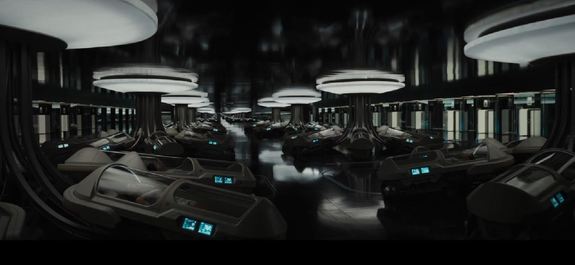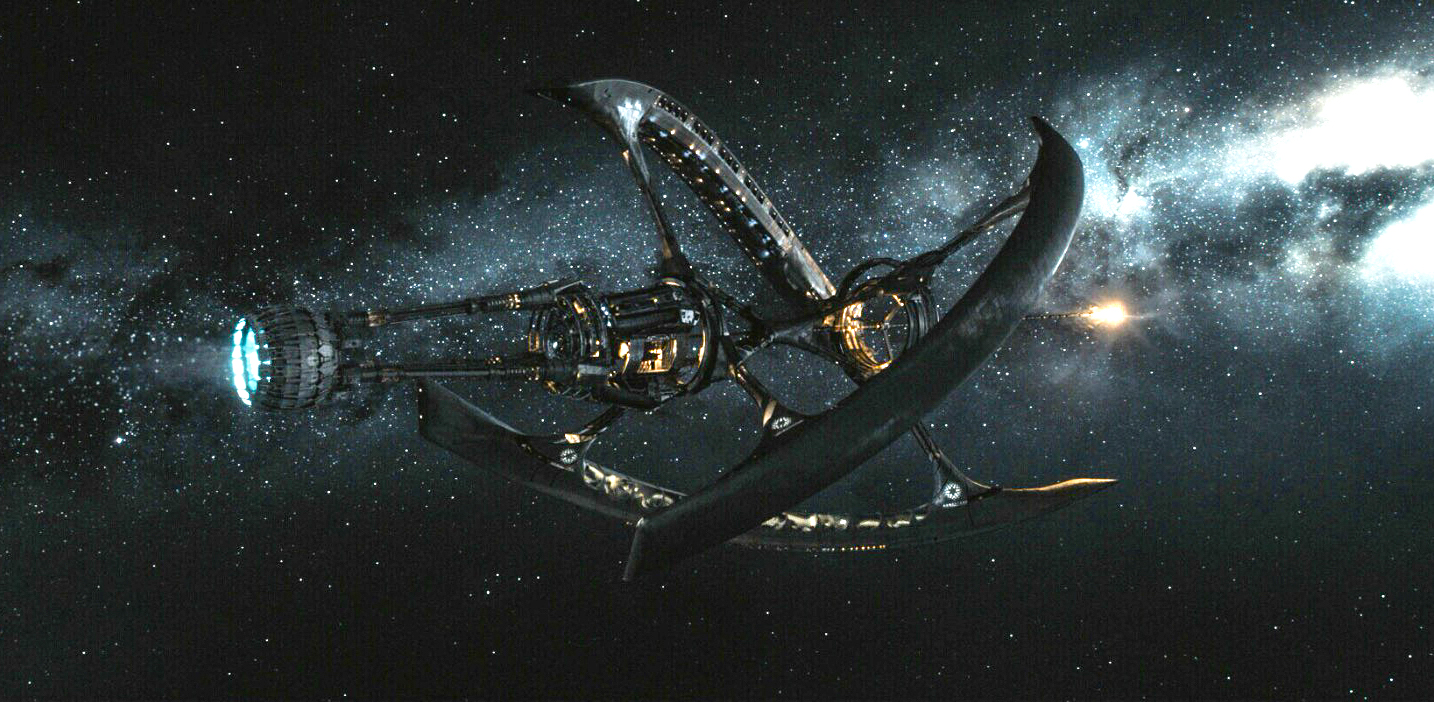The movie "Passengers," which opened yesterday (Dec. 21), explores the fascinations and perils of interstellar travel, but could the kind of starship portrayed in the movie ever exist in real life?
The film begins on board the Starship Avalon, which is carrying more than 5,000 passengers to a distant, habitable planet known as Homestead II.
Travelling at half the speed of light, the crew and passengers are expected to hibernate for 120 years before arriving. That is, until somebody accidentally wakes up 90 years early.
Is there anything remotely realistic about this spaceship? Space.com posed that question to several space travel experts, as well as Guy Hendrix Dyas, the film's production designer. Dyas looked at the history of movie spaceships (including the vehicles from the "Star Trek" and "Star Wars" universes) in his quest to come up with something unique for the new film.

The ship's design
The Avalon has three long, thin modules that wrap around a common center and spin (sort of like stripes on a barbershop pole). Dyas said he based that design on sycamore seeds. It appears that the spin also provides the ship with artificial gravity, similar to fictional ships in the movies "Interstellar" and "2001: A Space Odyssey." The ship is powered by eight nuclear fusion reactors, Dyas said, and can run autonomously, healing most systems even with the crew asleep (as seen in the film).
The ship's immense structure is about 1 kilometer (0.62 miles) in length, and Dyas said he imagines that it was assembled in space over decades. The film takes place at an indeterminate point in the future, Dyas said, but he assumed that by the time the ship was being built, humans would have the ability to mine some of the materials from nearby asteroids or the moon to save on transportation costs.
"My approach to the [ship] design was that I tried to go about it as though I was a cruise liner ship designer," Dyas told Space.com. "I wanted to put myself in the shoes of somebody who had been designing a craft that had a portion of it dedicated to entertainment, and of course that led to the array of colors and textual changes in the ship."
This approach led Dyas to design the more functional areas (such as the mess hall) in stainless steel, while a classy passenger pub was decorated in rich oranges, golds and reds, for example.
Banks of hibernation pods occupy huge halls in the ship. The crew slumbers in separate quarters, inaccessible to the passengers. The pods are clustered into small groups, perhaps (Dyas suggests) so that if one group's cluster fails, at least the other 5,000 passengers are theoretically unaffected.
The hibernation procedure is not really described in the film, but what's clear to moviegoers is what happens afterward: passengers are soothed by a holographic figure explaining where they are. They are escorted to an elevator, then guided to their individual cabin, where they can relax for the last four months of the journey.
In between resting in their quarters, passengers can also get to know the rest of the 5,000 people in common areas, such as the mess hall, the grand concourse, the pool or the bar.

Hibernation
While "Passengers" shows people placed in a hibernation state for decades at a time, that kind of technology does not exist today. There are situations, however, where patients can be put into induced comas with cooled saline solutions for a few days to allow traumatic injuries to heal.
In 2015, a company called SpaceWorks received a NASA Innovative Advanced Concepts grant to investigate the possibility of extending the timeframe of an induced stasis in humans even further than what is currently possible. Aerospace engineer John Bradford, the company's COO, told Space.com that induced stasis should be possible given that some mammals can hibernate for months. (NIAC grants are for early-stage work in far-off technologies.)
"We're not trying to extend the human lifetime," Bradford said, so the technology that SpaceWorks is pursuing is different from what is shown in "Passengers." But in other respects, the movie shows essentially the same thing his company strives for.
"We're trying to put people in a small container to minimize the mass and power requirements, and the consumables [during spaceflight]," he added, saying that during a long Mars journey of perhaps six months, putting astronauts into stasis would cut down on the amount of food required for the mission, not to mention the possibility of crew boredom.
And what about exercise? Bradford said it would be possible to keep up an astronaut's muscle mass using neuromuscular electric stimulation; there have been some positive results in comatose patients using that technique, he said.
Bradford said he had been lucky enough to see "Passengers" before its release, and that he was really pleased to see an emphasis on hibernation, and what happens in the moments after waking up, when the passengers are disoriented and extremely tired (since hibernation or stasis is not the same as sleep).
"That part of the storyline is usually jumped over," he said.
Interstellar propulsion
Nuclear fusion is a possible source of propulsion for interstellar ships, but the problem is the size of the reactors that would need to be assembled in space, or launched there, according to some scientists we talked to. So other methods are being considered to get spacecraft going at interstellar speeds.
One idea under consideration by Philip Lubin, a physics professor at the University of California, Santa Barbara, uses lasers. Under another NIAC grant, he is developing a concept known as Directed Energy Propulsion for Interstellar Exploration, which would generate propulsion from laser photonsreflected in a mirror. The long-term goal is to create a spacecraft that can, like in "Passengers," move at a significant fraction of the speed of light.
Antimatter engines are another possibility for fueling interstellar ships, said Andreas Tziolas, the co-founder and president of Icarus Interstellar. Antimatter particles are naturally occurring particles that are "opposites" to regular matter particles — so the positron is the antimatter equivalent to the electron; the particles have the same mass but are different in other ways, including electric charge (the electron is negative, the positron is positive). When matter and antimatter collide, they annihilate, and release energy.
"The energy [an antimatter engine] generates is very pure in that it generates a lot of photons when matter reacts with antimatter," he told Space.com. "All of the matter is annihilated and it turns into pure photonic energy. However, the photons themselves are hard to capture."
Though it's not stated directly it the film, it's possible the "Passengers" ship is being fueled by the interstellar medium — the tenuous collection of hydrogen particles that populate much of the universe. This concept was proposed in a 1960 thought experiment by American physicist Robert Bussard, who argued it would allow a ship to travel without having to haul fuel along for the ride.
But there's a problem with that idea, according to Geoffrey Landis, a science fiction author and NASA physicist. Since 1960, scientists have discovered that the medium is too sparse to allow fusion to happen, Landis said.
"The idea was, if you don't carry your fuel with you, you might be able to avoid having a simply enormous fuel tank," he said. But with that theory debunked, the problem remains about how to get to such an incredible speed while still hauling fuel with you. [Does Humanity's Destiny Lie in Interstellar Space Travel? (Op-Ed)]
From a practical standpoint, Landis also agreed that a ship that size would likely have to be built largely in space, and that will probably require asteroid mining.
While asteroid mining is still in the future, there are a couple of companies that are getting started on prospecting. Both Deep Space Industries and Planetary Resources have plans to scout out nearby asteroids to learn about their composition, and the possibilities for getting spacecraft out there. Asteroid-mining technology is in an early stage, but both companies are generating other products (such as Earth observation) that have received some support from customers.
Building a business case would take some time, but Landis said it would be very possible to create a spacecraft from extraterrestrial resources.
"In the long term, if we're going to build these enormous habitats, we are going to have to build them from material in space," he said. "That's a very feasible idea. There's literally millions of asteroids out there from which we could harvest materials without having to drag it out of the gravity well of the Earth."
Ship design
Landis also seemed to think that the Avalon creates gravity by rotating.
"I'm getting a little tired of artificial gravity in 'Star Trek' and 'Star Wars,'" he said, referring to the ability of the ships in these long-standing franchises to generate gravity by more theoretical means.
Experts interviewed for the story agreed that, in general, the ship also appears to take into account human factors, which means designing an environment so that it can best accommodate how humans operate.
An example is how the environment is decorated. Even on the International Space Station, the sterile gray interior is populated with pictures, signs and other mementoes from past crews. Individual astronauts can decorate their quarters to their liking, so that they have family pictures to look at during their six-month missions. So the décor choices that Dyas made are important in real-world spaceflight as well.
Looking at previews for the movie, Tziolas said he thinks the Starship Avalon is similar to the concept that Icarus Interstellar has proposed for an interstellar spaceship. Called Project Hyperion, this craft also has cruise ship-like amenities, room for 5,000 passengers and a spinning design for artificial gravity.
Tziolas added that he is so pleased that Hollywood is getting more realistic with its ship designs in general.
So could the ship from Passengers really exist? Our experts seemed to agree that there are some aspects that reflect real-world science, but some key questions remain about how such a massive vessel would make an interstellar trek.
Quelle: SC

